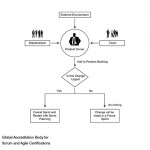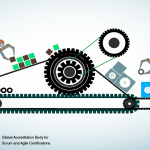Scrum helps organizations become more flexible and open to change. However, it is important to understand that although the Scrum framework emphasizes flexibility, it is also important to maintain stability throughout the change process. In the same way that extreme rigidity is ineffective, extreme flexibility is also unproductive. The key is to find the right balance between flexibility and stability because stability is needed in order to get work done. Therefore, Scrum uses iterative delivery and its other characteristics and principles to achieve this balance. Scrum maintains flexibility in that change requests can be created and approved at any time during the project; however, they get prioritized when the Prioritized Product Backlog is updated. At the same time, Scrum ensures that stability is maintained by keeping the Sprint Backlog fixed and by not allowing interference with the Scrum Team during a Sprint.
In Scrum, all requirements related to an ongoing Sprint are frozen during the Sprint. No change is implemented until the Sprint ends, unless a change is deemed to be significant enough to terminate the Sprint. In the case of an urgent or critical change, the Sprint is terminated and the team meets to plan a new Sprint incorporating the critical change. This is how Scrum accepts changes without creating the problem of changing release dates.
Scrum facilitates flexibility through transparency, inspection, and adaptation to ultimately achieve the most valuable business outcomes. Scrum provides an adaptive mechanism for project delivery in which a change in requirements can be accommodated without significantly impacting overall project progress. It is necessary to adapt to emerging business realities as part of the development cycle.
Flexibility in Scrum is achieved through five key characteristics:
- Iterative product development
- Time-boxing
- Cross-functional teams
- Customer value-based prioritization
- Continuous integration
One of the most defining features of Scrum framework is that it is change tolerant and adaptive. Scrum does not promote determining and firmly setting plans way in advance because it operates on the premise that project delivery is exposed to change and risk. The result is a high degree of flexibility and tolerance for change. The project is planned, executed, and delivered incrementally, so it is typically easy to incorporate changes throughout.










